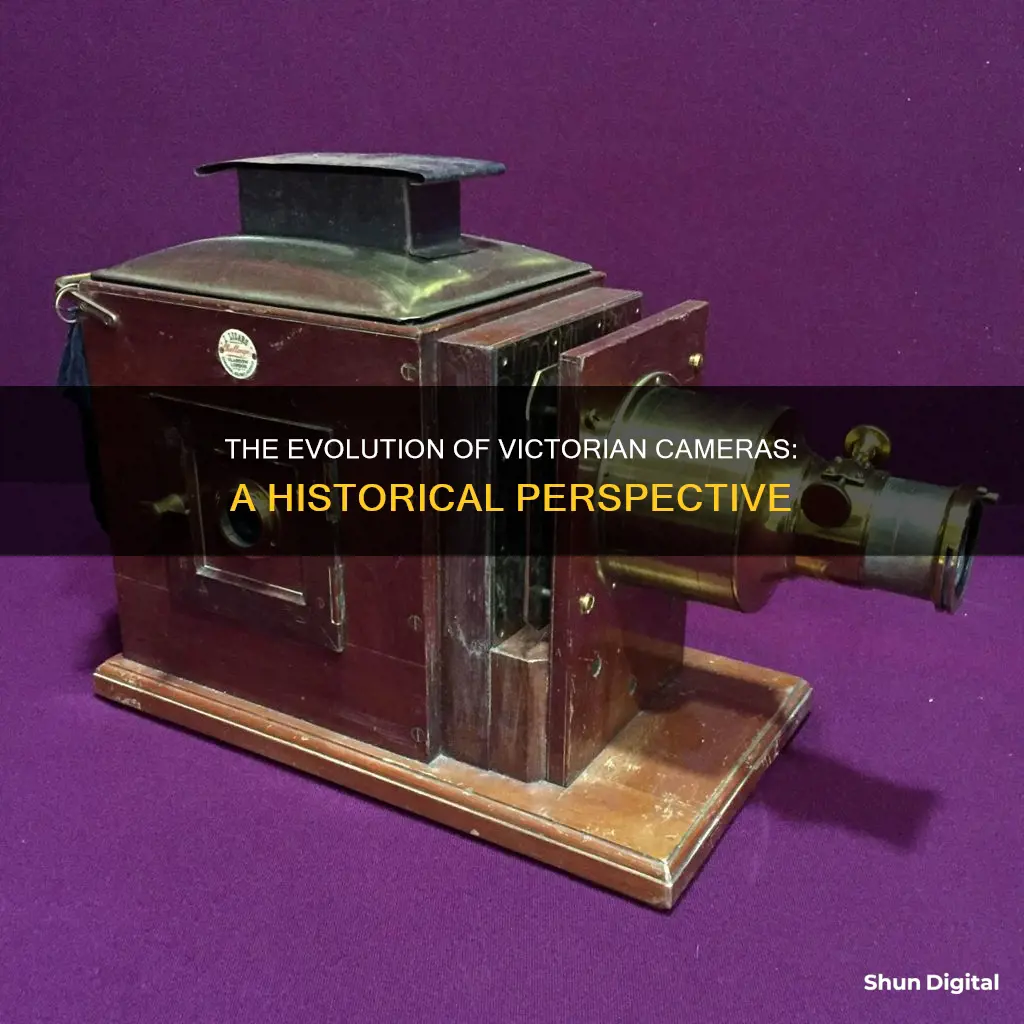
The Victorian era, a period in the United Kingdom marking the rule of Queen Victoria, was a time of many inventions, including the camera. The invention of the camera is usually attributed to Frenchman Louis Daguerre, who first announced his invention in 1839. However, William Henry Fox Talbot, a British scientist and scholar, had also been experimenting with photographic techniques and presented his work to the British Royal Academy in 1839. The camera during the Victorian era was quite different from what we know today; it was a huge thing with bellows like an accordion, and it used glass plates to capture images. These glass plates were coated with a light-sensitive solution and had to be loaded into the camera for each picture, making the picture-taking process much slower than today.
| Characteristics | Values |
|---|---|
| Date of Invention | 1839 |
| Inventor | Louis Daguerre |
| Country of Invention | France |
| First Popular Form of Photograph | Daguerreotype |
| Material of Plates | Copper |
| Coating of Plates | Silver Iodide |
| Exposure Time Outdoors | 10 minutes |
| Development Method | Mercury Vapour |
| Fixation Method | Strong Salt Solution |
| Invention of Dry Plates | 1870s |
What You'll Learn

The Victorian camera was a bellows camera
The Victorian camera dates back to the late 1800s. It used glass plates, which were exposed to capture images. The plates were rigid and had to be reloaded after each picture, making the picture-taking process slower. This type of camera was known as a plate camera. The name comes from the glass plates that were used instead of modern film.
The plate camera dates from the 'dry-plate' era, which began in the 1870s. This replaced the 'wet plate collodion' process, which was popular before. The wet plate process involved coating plates with a viscous solution of collodion dissolved in alcohol and ether, which was then sensitised in a silver nitrate solution. The wet plate had to be prepared, shot, and developed before it dried out, which could be challenging for photographers working on location.
The bellows camera had a front standard that held the lens and a rear standard, or 'tailboard', that moved to allow the photographer to focus. The bellows camera also had different lenses that could be mounted on wooden panels and inserted into the front standard.
Lithium Batteries: Powering Your Camera, What You Need to Know
You may want to see also

It used a negative to create a printed image
The Victorian era saw the advent of photography as we know it today. The first camera, or "camera obscura", was invented in the 17th century, but it was not until the 19th century that the first permanent photograph of a camera image was made.
The Victorian camera, as we know it, was made possible by the development of photographic techniques by inventors such as Louis Daguerre, William Henry Fox Talbot, and Frederick Scott Archer. The Daguerreotype, Calotype, and Wet Collodion processes revolutionized the way images were captured and reproduced, marking the beginning of photography as a tool and hobby for everyone.
The Calotype, or "Talbotype", process, invented by William Henry Fox Talbot, was the first to utilize negative printing. This process involved projecting an image through a lens onto a piece of chemically sensitized paper fixed inside the camera. This produced a negative image on the paper, which was then used to create positive prints. The negative image was placed in a printing frame with a second piece of sensitized paper beneath it and exposed to sunlight, creating a positive image. This process allowed for multiple positive prints to be made from a single negative, a significant advancement in the world of photography.
The Calotype camera itself was a small, homemade device measuring a bit more than 2 inches square. It had an acroat lens from a microscope and was nicknamed the "mousetrap" by Talbot's wife, Constance, due to its diminutive size.
The process of creating photographs using the Calotype method was cumbersome and time-consuming. It required long exposure times, often an hour or more, and the resulting images were less detailed than those produced by the Daguerreotype process. However, the ability to create multiple positive prints from a single negative was a game-changer. This negative-positive process formed the basis for modern photography and was widely used until the advent of digital imaging in the late 20th century.
The Calotype process empowered photographers and enthusiasts to experiment and innovate, pushing the boundaries of what was possible in the world of image capture and reproduction. It played a pivotal role in the evolution of photography, bridging the gap between the early days of the camera obscura and the modern era of digital imaging.
Charging Your 360 Fly Camera: A Quick Guide
You may want to see also

The Daguerreotype was the primary method of photography
The Daguerreotype process created a highly detailed image on a sheet of copper plated with a thin coat of silver without the use of a negative. The process was intricate and required great care. First, the silver-plated copper plate had to be cleaned and polished until the surface looked like a mirror. Then, the plate was sensitized in a closed box over iodine until it took on a yellow-rose appearance. The plate, held in a lightproof holder, was then transferred to the camera. After exposure to light, the plate was developed over hot mercury vapour until an image appeared. Finally, to fix the image, the plate was immersed in a solution of sodium thiosulphate or salt and then toned with gold chloride.
The Daguerreotype process only creates one image at a time, and multiple copies of the same picture could only be produced by re-photographing or by engraving directly from the plate. The images were extremely vulnerable to damage and could easily be brushed off, even after being fixed. Due to this fragility, they were usually protected with a cover glass and held in small leather-bound cases as treasured objects.
The Daguerreotype was widely used during the 1840s and 1850s but was almost completely superseded by 1856 with new, less expensive processes such as the ambrotype. However, it remained the primary method of photography for most people working in the new profession. Daguerreotypes were popular until the early 1860s, partly because Talbot's patent licenses cost up to £300 per year for professionals to use.
Japan-Made Cameras: A Comprehensive Brand Guide
You may want to see also

The process was invented by Louis Daguerre in 1839
The Victorian era in the United Kingdom was marked by the rule of Queen Victoria and was a period of many inventions, including the camera. The process of photography was invented and announced by Louis Daguerre in 1839, and he gave his name to the first popular form of photograph – the Daguerreotype. The invention was announced by François Arago, secretary of the French Academy of Sciences, on 7 January 1839, with full details revealed on 18 August the same year.
The Daguerreotype process enabled positive images of great detail and clarity to be recorded by a camera containing copper plates coated in iodized silver. The exposure time outdoors could be as little as ten minutes, and the latent images were developed by exposure to mercury vapour and then fixed by a strong salt solution. The image was made of a combination of silver and mercury resting on the plate and was extremely vulnerable to damage. Because they were so fragile, they were usually protected with a cover glass and held in small leather-bound cases as treasured objects.
Daguerre made his first successful experiment in 1837 when he produced an indoor still-life study, The Artist's Workshop. A year later, he held a Paris exhibition of daguerreotypes, including Boulevard du Temple, Paris (1838). This famous street scene contains the first recorded image of a human being: a man having his shoes shined, who was therefore stationary long enough to appear on the plate.
The Daguerreotype camera was designed by Marc Antoine Gaudin of Paris in 1841 and was made commercially by the instrument-maker NMP Lerebours. The invention was an immediate hit, and France was soon gripped by 'daguerreotypomania'. Daguerre released his formula, and anyone was free to use it without paying a licence fee everywhere except in Britain, where he had secured a patent.
Unlocking Pixel 3a's Camera Modes
You may want to see also

The camera was used to take photos of the dead
The camera was invented in 1839 by Frenchman Louis Daguerre, who unveiled the first popular form of photograph: the Daguerreotype. This invention made portraiture commonplace, as many people who couldn't afford painted portraits could now sit for a photography session.
Post-mortem photography, or the practice of photographing the recently deceased, became a common way for people to remember and mourn their dead loved ones. This was especially true for families with lots of children, as it was common for children to die before their fifth birthday. In the mid-1800s, photography was becoming more popular and affordable, leading to memento mori photographic portraiture.
In Victorian England, it was common for families to pose with the deceased. Infants were often photographed asleep, and young ladies were shown elegantly reclining, the disease having taken their lives but increased their beauty. Long exposures meant that the dead were often seen more sharply than the living, who might be slightly blurred due to their movement.
In Victorian times, it was also common to photograph deceased young children or newborns in the arms of their mother. Some images, especially tintypes and ambrotypes, had a rosy tint added to the cheeks of the corpse. Later photographs showed the subject in a coffin, sometimes surrounded by a large group of funeral attendees.
Unlocking Photography: Understanding Camera's S Mode
You may want to see also
Frequently asked questions
The first cameras were invented in the early 19th century. The original Daguerreotype camera was invented in 1839 by Frenchman Louis Daguerre.
The Daguerreotype camera was the first popular form of photography. It used a camera containing copper plates coated in iodized silver to record positive images.
The Victorian camera used the properties of light to create an image on a piece of film called a negative. This film was then processed with chemicals to create a printed image.
The bellows camera was the most commonly used type of camera during the Victorian era.
Victorian photography techniques are still in use today. The three primary elements of photography that were discovered during this time, such as developing, fixing, and printing, are the foundation for modern photography.







